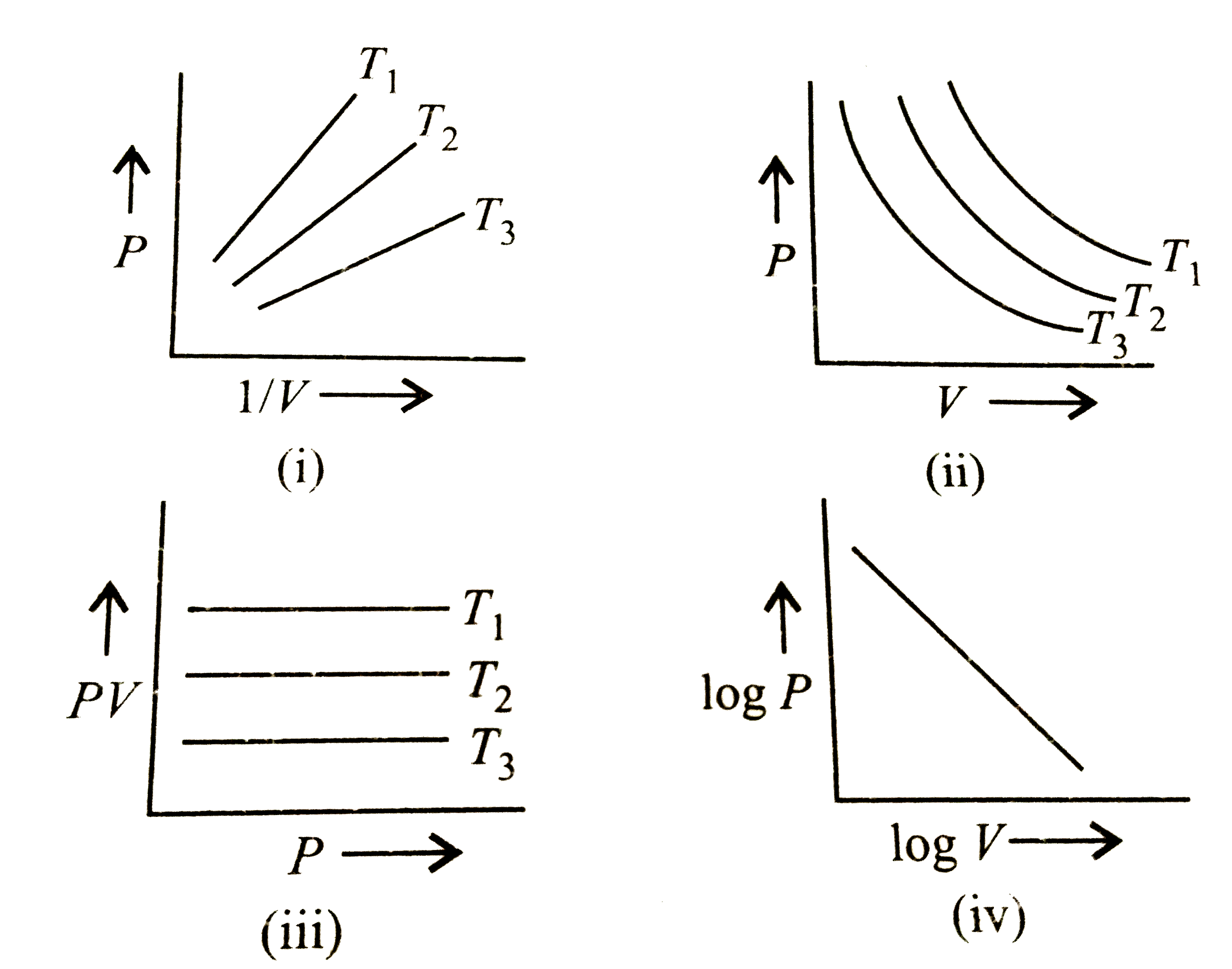A student performed an experiment to measure pressure and volume of a gas at constant temperature and noted the following:
Pressure (mm of Hg)Volume(cm3)10080125x20040y32
Calculate the value of x and y. Which law was used in the calculation ? Draw a suitable graph.
To solve the problem, we will use Boyle's Law, which states that for a given mass of gas at constant temperature, the product of pressure (P) and volume (V) is a constant. This can be mathematically expressed as:
P1V1=P2V2
Step 1: Calculate the value of x
Given the first case:
- P1=100mm of Hg
- V1=80cm3
- P2=125mm of Hg
- V2=x
Using Boyle's Law:
P1V1=P2V2
Substituting the known values:
100×80=125×x
Calculating:
8000=125x
Now, solve for x:
x=8000125=64cm3
Step 2: Calculate the value of y
Given the second case:
- P1=200mm of Hg
- V1=40cm3
- P2=y
- V2=32cm3
Using Boyle's Law again:
P1V1=P2V2
Substituting the known values:
200×40=y×32
Calculating:
8000=32y
Now, solve for y:
y=800032=250mm of Hg
Summary of Results
- The value of x is 64cm3
- The value of y is 250mm of Hg
- The law used in the calculations is Boyle's Law.
Step 3: Draw a Suitable Graph
To graph the relationship, we will plot Pressure (P) on the y-axis and Volume (V) on the x-axis. The points to plot based on the data are:
1. (80, 100)
2. (64, 125)
3. (40, 200)
4. (32, 250)
After plotting these points on the graph, connect them to illustrate the inverse relationship between pressure and volume, which is characteristic of Boyle's Law.
- P1=100mm of Hg
- V1=80cm3
- P2=125mm of Hg
- V2=x
P1V1=P2V2
100×80=125×x
8000=125x
x=8000125=64cm3
- P1=200mm of Hg
- V1=40cm3
- P2=y
- V2=32cm3
P1V1=P2V2
200×40=y×32
8000=32y
y=800032=250mm of Hg
- The value of x is 64cm3
- The value of y is 250mm of Hg
- The law used in the calculations is Boyle's Law.
1. (80, 100)
2. (64, 125)
3. (40, 200)
4. (32, 250)
Topper's Solved these Questions
- STUDY OF GAS LAWS BOOK - ICSECHAPTER - STUDY OF GAS LAWS EXERCISE - TOPIC 2 (1 Mark Questions )
10 Videos
- STUDY OF GAS LAWS BOOK - ICSECHAPTER - STUDY OF GAS LAWS EXERCISE - TOPIC 2 (2 Marks Questions )
27 Videos
- STUDY OF GAS LAWS BOOK - ICSECHAPTER - STUDY OF GAS LAWS EXERCISE - TOPIC 1 (3 Marks Questions )
17 Videos
- SPECIMEN PAPER 3BOOK - ICSECHAPTER - SPECIMEN PAPER 3EXERCISE - SECTION II
35 Videos
- STUDY OF THE FIRST ELEMENT - HYDROGENBOOK - ICSECHAPTER - STUDY OF THE FIRST ELEMENT - HYDROGENEXERCISE - TOPIC 2 Properties of Hydrogen, Oxidation nd Reduction (5 MARKS QUESTIONS)
29 Videos
Similar Questions
A student performed an experiment to measure - pressure and volume of a gas at constant temperature and noted the following:

Calculate the value of x and y. Which law was used in the calculations ? Draw graphs to show:
volume plotted against pressure.
View SolutionA student performed an experiment to measure - pressure and volume of a gas at constant temperature and noted the following:

Calculate the value of x and y. Which law was used in the calculations ? Draw graphs to show:
PV plotted against pressure
View SolutionThe percentage change in the pressure of gas at constant temperature is 200% (increases). Calculate the percentage change in the volume of the gas.
View SolutionThe percentage change in the pressure of a given mass of a gas filled in a container at constant temperature is 100%. Calculate the percentage change in its volume.
View SolutionIf 42 g of an unknown gas X occupies a volume of 125 L at 0.3 bar pressure and 300 K temperature then the gas X could be :
View SolutionGraphs between pressure and volume are plotted at different temperatures . Which of the following isotherms represents Boyle's law as PV = constant ? (T1>T2>T3)

View Solution2 litres of a gas is enclosed in a vessel at a pressure of 760 mm Hg. If temperature remains constant, calculate pressure when volume changes to 4dm3
View SolutionAt constant temperature, a gas is at a pressure of 1080 mm Hg. If the volume is decreased by 40%, find the new pressure of the gas.
View SolutionThe pressure of a gas of given mass of constant temperature is reduced to half of its value. Calculate the percentage change in its volume.
View Solution3 L of gas is enclosed in a vessel at a pressure of 760 mm Hg. If temperature remain constant , calculate pressure when volume changes to 6L
View Solution
